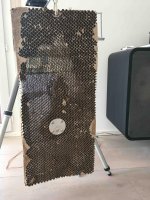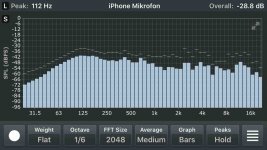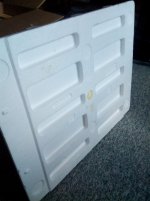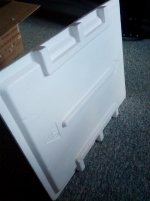This looks really interesting.
What exciters do you use. Did you tried with smaller panels? Maybe?
Sorry I answered so shortly.
Small full range panels don’t have enough bass without a subwoofer, to my liking.
Did I try smaller panels on top of my plexiglass panels? Yes! I tried all the above thicknesses with 1” by 12”, 2” by 24”, 3” by 36 and 6” by 36”. I did not try square, round or other shapes. Balsa sounded best as did the 6 by 36” panels. Smaller and narrower panels beamed too much. I got all these sizes at the
Hobby Shop.
I hope that answers your question
Small full range panels don’t have enough bass without a subwoofer, to my liking.
Did I try smaller panels on top of my plexiglass panels? Yes! I tried all the above thicknesses with 1” by 12”, 2” by 24”, 3” by 36 and 6” by 36”. I did not try square, round or other shapes. Balsa sounded best as did the 6 by 36” panels. Smaller and narrower panels beamed too much. I got all these sizes at the
Hobby Shop.
I hope that answers your question
Close listening with an ear up close (3-5 inches)to the panels clearly shows that the HF extension and crisp clear highs are coming from the balsa and not the plexiglass.
I tried vertical orientation of the balsa panel and it tended to “beam” somewhat... especially with very thin panels 1-3 inches wide.
This is very interesting, have you thought to test Lexan (polycarbonate) instead of Plexiglas?
Since I have heard it should be stronger/harder.
I have thought of It but Lexan is much more expensive, harder to machine. I once tried a sheet of Lexan 2 by 5 feet by 3/8 inch. This sheet cost $500. It was very hard to drive and sounded muted. Not sure why. Maybe it was the simple large mass of the panel and the low output driver. The density of acrylic vs Polycarbonate is similar 1.18 vs 1.2 gm/cc.
Not sure what the benefit of Lexan would be. Thoughts?
Not sure what the benefit of Lexan would be. Thoughts?
Here is my recent experiment. I found that my plexiglass panels sound good from either side so... I used a neodymium ring magnet to attach various panels of different size and thicknesses to the back of the driver for a hybrid panel. The sound is quite impressive and a n improvement in high end and presence. No measurements yet
Dave,
Quite interesting what you have going there! It would have never dawned on me to try that! Is the mass of the magnet and housing actually vibrating at high frequencies? It seems so counter-intuitive, with all of the mass of the magnet and housing (given all the talk about voice coil mass limiting high end output). What do you think about reversing the driver, so the voice coil will act on the balsa instead of the Plexiglas? Nice work!
Bruce
Newton’s Third Law “ For every action there is an equal and opposite reaction”
If you think about it, for a unsupported exciter( no spline ) the exciter MUST vibrate at the same frequency but in opposite phase as the voice coil and in this case, the plexiglass.
Another way to do this would be to mount a spacer and the balsa on the plexiglass side. I think it would act as a whizzer cone. Haven’t tried that yet as I like the magnet mount idea for quick trials and different materials. In that iteration the two panels would be in phase. Not sure if that matters for a DML. Experiments could also be done with the whizzer non coaxial with the exciter.
“ The art so long to learn, the life is so short”
If you think about it, for a unsupported exciter( no spline ) the exciter MUST vibrate at the same frequency but in opposite phase as the voice coil and in this case, the plexiglass.
Another way to do this would be to mount a spacer and the balsa on the plexiglass side. I think it would act as a whizzer cone. Haven’t tried that yet as I like the magnet mount idea for quick trials and different materials. In that iteration the two panels would be in phase. Not sure if that matters for a DML. Experiments could also be done with the whizzer non coaxial with the exciter.
“ The art so long to learn, the life is so short”
Also,
The mass of the plexi panel is huge compared to the driver, magnet and balsa. Might also be some frequency dependant impedance matching issues due to the mass and density differences between the two” sides “of Newton’s equation.
The mass of the plexi panel is huge compared to the driver, magnet and balsa. Might also be some frequency dependant impedance matching issues due to the mass and density differences between the two” sides “of Newton’s equation.
Newton’s Third Law “ For every action there is an equal and opposite reaction”
If you think about it, for a unsupported exciter( no spline ) the exciter MUST vibrate at the same frequency but in opposite phase as the voice coil and in this case, the plexiglass.
Another way to do this would be to mount a spacer and the balsa on the plexiglass side. I think it would act as a whizzer cone. Haven’t tried that yet as I like the magnet mount idea for quick trials and different materials. In that iteration the two panels would be in phase. Not sure if that matters for a DML. Experiments could also be done with the whizzer non coaxial with the exciter.
“ The art so long to learn, the life is so short”
Your explanation helps. So then, it is positive to have the weight of the ring magnet and exciter magnet be with the lighter balsa, to balance the opposing (high) mass of the Plexi?
Obviously the balsa lacks low end due to its size - makes me wonder if it is also reduced by having it right in front of the Plexi, like when a panel is put on a wall?
Either way, I like your concept, to get more presence and high end, from one driver!
Short answer...”who knows”. I feel like the frog that caught the fly by chance. Lots of experimenting to do. This combination sounds really good to me and all those who have heard it and looks cool to boot
I am thinking that since the plexiglass panel has high mass there is significant impedance to motion. Because there is less mass moving in the opposite direction ( exciter, magnet and balsa) there should be less impedance to
motion. I am not an engineer and I am only theorizing why this is working.
From physics Force = mass x acceleration
Since the force is equal on both sides but in opposite directions of the driver coil ....
Mass pl. x. ACCELLERATION PL = mass driver, magnet and balsa. x. accelleration driver, magnet and balsa
So the balsa accelleration at a given frequency must be greater than the plexiglass.
I know this impedance stuff is frequency dependent but that topic is above my pay grade. Perhaps one of the engineers on this thread could chime in.
motion. I am not an engineer and I am only theorizing why this is working.
From physics Force = mass x acceleration
Since the force is equal on both sides but in opposite directions of the driver coil ....
Mass pl. x. ACCELLERATION PL = mass driver, magnet and balsa. x. accelleration driver, magnet and balsa
So the balsa accelleration at a given frequency must be greater than the plexiglass.
I know this impedance stuff is frequency dependent but that topic is above my pay grade. Perhaps one of the engineers on this thread could chime in.
cardboard / craft paper honeycomb
Hi XRK
Did you made any tests and work with your boards?
this week I've worked on a kind of honeycomb board like yours. It is not that stiff as my other cardboard honeycomb boards. One difference is the type of layer. It is made of Craft/Kraft paper. The cardboard honeycomb with screw mounted exciter sounds in mids and highs very detailed and super clear, it remembers me of the old Quad ESL, but lacking the body. The paper honeycomb lacked in details but tonally is much better balanced for me. So I decided to work on the softer sounding board.
After trying to make them stiffer with a kind of 'papier mache' (modified rice glue), I decided later to take away the layers and made one side with paper and rice glue (mixed with paper and cardboard), because a bigger part of the before soaked layer did not make good contact with the honeycomb structure.
I've now one side open (with the honeycomb structure) and one side with a new layer (picture). The exciter mounted on each side and listening tests of all four sides showed the exciter on the layer side and the ear on the open side as best for me. The sound has some details, voice is again in front as well instruments with percussive sounds. Electronic Organ, acoustic and electric bass has a good body. The efficiency overall is much less than with the cardboard panels but still no problem with an 8 Watts amp.
I think there is a good potential for me to work and improve stiffness on the layer side and partially on the open honeycomb (esthetically a must as you can see;-)
I think I just scored a major find on a potential DML panel material. I got a large mirror delivered the other day. The box had a 76in x 32in x 15mm thick brown paper faced honeycomb core material to protect the mirror inside the box. It is huge, very stiff and light weight. If we like the sound of paper cone drivers, this just might be the thing. I want a pair of stereo panels. Should I cut length wise for two 76in tall x 16in wide panels for a "Tall Brunette" speaker? Or the other way at 38in x 32in pair of panels? I think the tall ones will get deeper bass from what I have read. Has anyone else tried cardboard honeycomb?
Closeup:
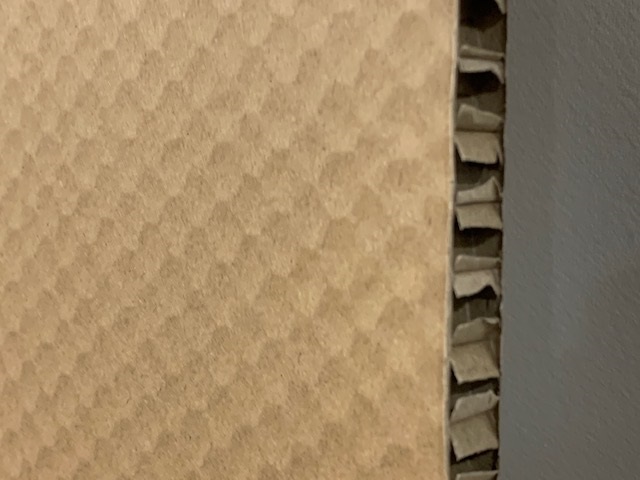
Hi XRK
Did you made any tests and work with your boards?
this week I've worked on a kind of honeycomb board like yours. It is not that stiff as my other cardboard honeycomb boards. One difference is the type of layer. It is made of Craft/Kraft paper. The cardboard honeycomb with screw mounted exciter sounds in mids and highs very detailed and super clear, it remembers me of the old Quad ESL, but lacking the body. The paper honeycomb lacked in details but tonally is much better balanced for me. So I decided to work on the softer sounding board.
After trying to make them stiffer with a kind of 'papier mache' (modified rice glue), I decided later to take away the layers and made one side with paper and rice glue (mixed with paper and cardboard), because a bigger part of the before soaked layer did not make good contact with the honeycomb structure.
I've now one side open (with the honeycomb structure) and one side with a new layer (picture). The exciter mounted on each side and listening tests of all four sides showed the exciter on the layer side and the ear on the open side as best for me. The sound has some details, voice is again in front as well instruments with percussive sounds. Electronic Organ, acoustic and electric bass has a good body. The efficiency overall is much less than with the cardboard panels but still no problem with an 8 Watts amp.
I think there is a good potential for me to work and improve stiffness on the layer side and partially on the open honeycomb (esthetically a must as you can see;-)
Attachments
honeycomb card-/paperboard
the pink noise frequency band is made very close (2'') to the panel at the exciter and than turning(crossing) near the edges and coming back to the exciter. The peak level indications show that.
the pink noise frequency band is made very close (2'') to the panel at the exciter and than turning(crossing) near the edges and coming back to the exciter. The peak level indications show that.
There are a few places online that you can get the honeycomb card board that may be suitable:
McMaster-Carr
About $10 a sheet of 20" x 48" x 0.5" honeycomb core cardboard sheets
48" x 96" x 1/2" Honeycomb Sheets | Packaging Hero
Bigger sheets 96" x 48" x0.5"
And to answer the question, yes some have used it in the past, and if its light enough and not too thick, it can work. However most tried to shellac the surfaces, but the honeycomb structure won't allow internal shellacing like regular single wall corrugated cardboard can. But not enough people have really played with it over the years it seems because honeycomb is hard to find or expensive...
geo
McMaster-Carr
About $10 a sheet of 20" x 48" x 0.5" honeycomb core cardboard sheets
48" x 96" x 1/2" Honeycomb Sheets | Packaging Hero
Bigger sheets 96" x 48" x0.5"
And to answer the question, yes some have used it in the past, and if its light enough and not too thick, it can work. However most tried to shellac the surfaces, but the honeycomb structure won't allow internal shellacing like regular single wall corrugated cardboard can. But not enough people have really played with it over the years it seems because honeycomb is hard to find or expensive...
geo
Last edited:
There are a few places online that you can get the honeycomb card board that may be suitable:
McMaster-Carr
About $10 a sheet of 20" x 48" x 0.5" honeycomb core cardboard sheets
48" x 96" x 1/2" Honeycomb Sheets | Packaging Hero
Bigger sheets 96" x 48" x0.5"
And to answer the question, yes some have used it in the past, and if its light enough and not too thick, it can work. However most tried to shellac the surfaces, but the honeycomb structure won't allow internal shellacing like regular single wall corrugated cardboard can. But not enough people have really played with it over the years it seems because honeycomb is hard to find or expensive...
geo
Hi geo
Thank you for the information and links to distributors.
I have two panels (cardboard, crushproof,..) which are similar to those in your distributor links. The two panels I'm working actually which I found at a recycling corner, are described as a filling material for shipping (similar to that of XRK). The weight is approx. 50% of the cardboard panel. The benefit of the paperboard panel is, that one layer could be taken off very easily. The result is a huge increase of the vibrating panel surface. The most critical point is the contact of the honeycomb structure to the layer. I've found the information from a manufacturer, that the honeycombs and the layers are welded with heat. As one of the next steps I'm thinking to improve this point with glue and I'm searching for an easy and reliable method to do this. The challenge is, to apply sufficient glue to the contact area (honeycomb and layer) and not to transform the material with the water based glue, which I would like to use. I must say, that I'm a beginner in working with rice glue, papier mache, etc. and will certainly improve my technique over time;-)
Eric
I've been going through the recordings posted on this site and have been listening to the similar dml sound, through the various materials.
I had to check that gapmedias recording of walking on the moon wasn't mine! (Very similar to the eps in many ways)As I have this recording of my own.
Because I've gone through the recording in a room problems ,I find it easier to ignore and blot out the room .
Although I do now record the panels with the microphone at about 1mtr in front of them ,to minimise the room response.
I did try some 10mm twin polycarbonate some time ago and wasn't impressed,so might give the 4mm a go if I get a chance.
Gapmedia.
Are you still using polycarbonate or have you moved on? Any new recordings?or measurements?
And thank you everyone for your recordings,very interesting.
Steve
I had to check that gapmedias recording of walking on the moon wasn't mine! (Very similar to the eps in many ways)As I have this recording of my own.
Because I've gone through the recording in a room problems ,I find it easier to ignore and blot out the room .
Although I do now record the panels with the microphone at about 1mtr in front of them ,to minimise the room response.
I did try some 10mm twin polycarbonate some time ago and wasn't impressed,so might give the 4mm a go if I get a chance.
Gapmedia.
Are you still using polycarbonate or have you moved on? Any new recordings?or measurements?
And thank you everyone for your recordings,very interesting.
Steve
Hello everyone,
finally made it through the 200 pages of this thread.
I have started experimenting with DMLs sometime last year after watching the Tech Ingredients video and really like the sound of them.
After a couple of experiments I wanted to share some of my findings, but keep in mind I am by no means an expert in this stuff and have only my ears to go by, since I don't have any measuring equipment.
Firstly I was excited to tell you about honeycomb cardboard as panel material, but xrk and 100ohm found it themself recently.
I got mine from amazon in germany:
Pappwabenplatte kartonkaschiert, 5 mm x 50 cm x 70 cm, 810 g/m2, formstabile Wabenplatte zum Bekleben geeignet, beidseitge Abdeckung aus Karton, schwarz: Amazon.de: Burobedarf & Schreibwaren
I have one 1x50x70cm panel of it in use and recently one with 0,5x50x70cm arrived, which I will test soon.
It is definitly lighter than wood and still very stiff, which gives it an overall higher output especially in the highs, but still has suprisingly good lows.
I added it to my existing setup consiting of two 0,4x70x90cm birchply panels I have curved using a curved wood bracing, which brings me to my second point:
Introducing some kind of curve seems to improve the output of a panel, probably because it increases its stiffness, but again I have no actual data to back up this claim.
Another thing I noticed, then I tried the packing styrofoam panel in the pictures, is that even though the over all sound wasn't that good it had significantly more LF output than a similar sized styrofaom panal with just a plain shape. For the people using XPS or EPS it might be worth trying to cut additional structure into the panels to see if it improves the output. Kinda like the bracings in for example a guitarr.
Also I tested the method, presented by offgridkindaguy awhile back, by attaching a small CF panel with an exciter to a kinda big wooden frame with a thin piece of plastic in it (used to prevent small caliber shells hitting the person next to you) and again while the overall sound wasn't great it had good LF output so there is defintitly somthing to this method.
To the question of exciters the DAEX30HESF-4 was the first one I got and still think it is the best, I also tried the DAEX32QMB-4 in the hope of more bass output but was dissapointed by it.
I also have a question, I have achieved my best results by combining different panel materials for example wood + xps or wood + honeycomb cardborad, but this method of combining materials doesn't seem very common and I was wondering why?
Well thats all for now...
-Leonard
finally made it through the 200 pages of this thread.
I have started experimenting with DMLs sometime last year after watching the Tech Ingredients video and really like the sound of them.
After a couple of experiments I wanted to share some of my findings, but keep in mind I am by no means an expert in this stuff and have only my ears to go by, since I don't have any measuring equipment.
Firstly I was excited to tell you about honeycomb cardboard as panel material, but xrk and 100ohm found it themself recently.
I got mine from amazon in germany:
Pappwabenplatte kartonkaschiert, 5 mm x 50 cm x 70 cm, 810 g/m2, formstabile Wabenplatte zum Bekleben geeignet, beidseitge Abdeckung aus Karton, schwarz: Amazon.de: Burobedarf & Schreibwaren
I have one 1x50x70cm panel of it in use and recently one with 0,5x50x70cm arrived, which I will test soon.
It is definitly lighter than wood and still very stiff, which gives it an overall higher output especially in the highs, but still has suprisingly good lows.
I added it to my existing setup consiting of two 0,4x70x90cm birchply panels I have curved using a curved wood bracing, which brings me to my second point:
Introducing some kind of curve seems to improve the output of a panel, probably because it increases its stiffness, but again I have no actual data to back up this claim.
Another thing I noticed, then I tried the packing styrofoam panel in the pictures, is that even though the over all sound wasn't that good it had significantly more LF output than a similar sized styrofaom panal with just a plain shape. For the people using XPS or EPS it might be worth trying to cut additional structure into the panels to see if it improves the output. Kinda like the bracings in for example a guitarr.
Also I tested the method, presented by offgridkindaguy awhile back, by attaching a small CF panel with an exciter to a kinda big wooden frame with a thin piece of plastic in it (used to prevent small caliber shells hitting the person next to you) and again while the overall sound wasn't great it had good LF output so there is defintitly somthing to this method.
To the question of exciters the DAEX30HESF-4 was the first one I got and still think it is the best, I also tried the DAEX32QMB-4 in the hope of more bass output but was dissapointed by it.
I also have a question, I have achieved my best results by combining different panel materials for example wood + xps or wood + honeycomb cardborad, but this method of combining materials doesn't seem very common and I was wondering why?
Well thats all for now...
-Leonard
Attachments
- Home
- Loudspeakers
- Full Range
- A Study of DMLs as a Full Range Speaker
